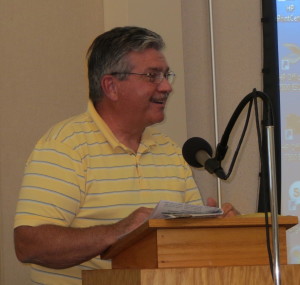Longtime temporary facility now posing health risks
By Kathleen Brady Shea, Managing Editor, The Times

The lower level of the makeshift New Garden Township Police building is now off-limits due to high mold concentration.
The well-respected New Garden Township Police Department stands in stark contrast to the decrepit building it occupies: a makeshift facility so mold-ridden that the lower floor has been virtually quarantined, prompting one supervisor to label it “a dump.”
At a work session Wednesday night, Police Chief Gerald Simpson told the board that officers have had to store equipment at home because so much space has been lost to the contamination. Remedying that situation was one of several thorny, financial issues the supervisors tackled at a meeting attended by a single resident.
Jim DiLuzio urged the supervisors to be frugal as they grapple with multiple money-draining problems, pointing out that many people in the township are struggling. “I’m really begging you to keep moving forward but within our means,” he said. He got no disagreement.
The three-hour session was frequently punctuated by concerns about spending limits and time constraints, as many of the pending issues carry deadlines. For example, the supervisors want to have the police contract negotiated well in advance of Dec. 12, when the board will decide whether to continue a pilot program that provides 24-hour-a-day police coverage. The board authorized Simpson and interim Township Manager Spence Andress to begin talks with the union.
The board reluctantly agreed earlier this month that renting a temporary trailer was needed to get the police out of an unsafe building; however, they said they hoped to defray some of the estimated $33,000 cost by doing some installation work in-house. The current facility was also intended to be temporary.
“In almost 20 years, we haven’t had a permanent facility,” remarked Officer Gerard M. Lindenlauf, president of the New Garden Police Officers Association.
Simpson said that a trailer last used at the U.S. Open in Merion could become a police facility by mid-August, but he expressed fears that the township staff could be stretched thin with responsibilities for hooking up systems that include cable, phone, water, sewer, electric and computers. “The biggest concern I have is our IT systems,” said Simpson. “Our biggest priority is not interrupting our service to the public.”
The supervisors agreed that Simpson, Andress and Public Works Director Kenneth Reed should be involved in discussions about what outside contractors might be needed. For a more permanent solution, the board asked Simpson to compile a list of criteria for a police station to avoid what several termed “putting a round peg into a square hole.”
Supervisor Bob Norris agreed to work with Simpson to devise a business plan, a collaboration they concurred would include consultations with other municipalities that have gone through the same process. Among the possibilities: building at the current location, finding a new site, or expanding the lower level of the township building. DiLuzio suggested if more space were needed, perhaps the police could use the upper floor and move the township administration downstairs.
Supervisors Chairman Stephen Allaband said he believed one of the past difficulties in making a decision stemmed from the challenge of predicting the future, which many believe will include more regional policing. Allaband said the township didn’t want to commit to a building that wouldn’t work long term. Supervisor Betty Gordon said she had always worried that the township building’s lower level would not provide the police department with the space it needs. She said “this is the first time in three and a half years” that I’ve heard that it would be possible to add space downstairs.
Supervisor Robert J. Perrotti said when the supervisors approved the construction of the township building – a plan he opposed as too expensive – the basement was earmarked for the police department, but the supervisors backed off the extra half-million needed to complete it. However, Perrotti said the building’s sewer and electrical systems were put in with the understanding that the work would be done in the future.
“In nearly 12 years,” he said the township has paid for three different plans for housing the police department in the lower level, none of which have materialized. Lindenlauf pointed out that none of the proposals ever involved any input from the police.
Stressing that he has no interest in “a palace,” Simpson said he was not opposed to the township building as long as it meets the needs of law enforcement.
The need to finance a permanent police facility prompted discussion about whether to increase the amount of the approximate $1.2 million mortgage the township wants to refinance on its building. Norris suggested that borrowing when interest rates are low benefits the township, but Perrotti countered that “the more you borrow, the more you have to pay.”
Reed asked the board to consider the fact that a number of aging township vehicles, roads, and bridges require repair or replacement.
Andress said he would provide the supervisors with figures on the lowest, longest-term, fixed interest rates for $1.2 million, $1.7 million and $2.2 million so the numbers can be compared. The supervisors agreed that it makes sense to pay off a $2 million open-space loan, $1.8 million of which has not been used. A similar discussion took place in 2009, according to township minutes; however, at the time, the township would have incurred a penalty. That provision expires next month, Andress said.
The supervisors explained that the loan, obtained in anticipation of some land acquisitions that didn’t pan out, preceded the township’s open-space tax fund. Since that fund now contains about $1 million, the loan can be paid off, leaving nearly $1 million in reserves for future purchases.





